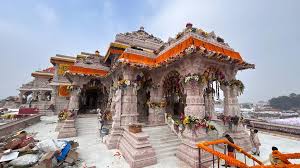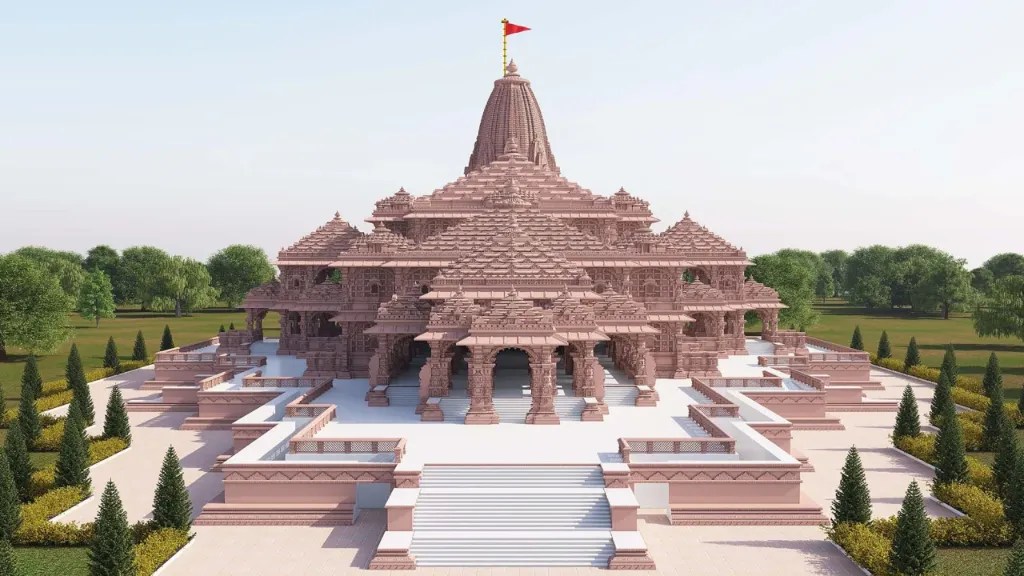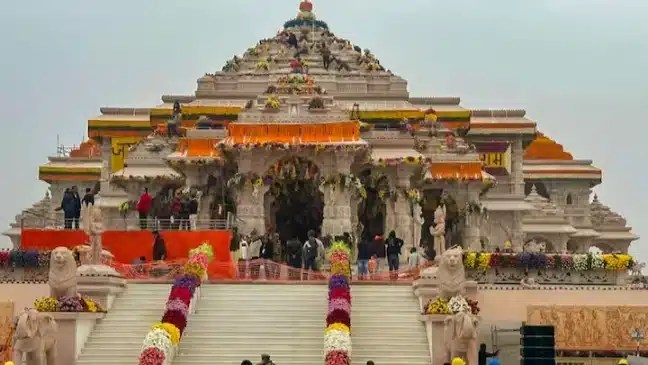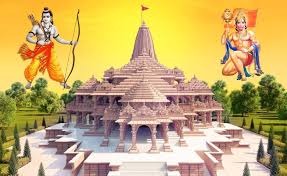The Ram Mandir in Ayodhya is not just a place of worship — it is a symbol of faith, heritage, identity, and cultural unity. For millions of Hindus around the world, the construction and consecration of this temple represent the fulfillment of a centuries-old dream. With its grand architecture, spiritual depth, and historical background, the Ram Mandir today stands as one of the most significant cultural monuments in modern India.
In this comprehensive article, we explore the history, disputes, construction timeline, architecture, inauguration, tourism impact, and global influence of the Ram Mandir. Whether you are a researcher, devotee, traveler, or history enthusiast, this article will provide everything you need to know.
1. Introduction – Why the Ram Mandir Is So Important
The Ram Mandir in Ayodhya is far more than a temple made of stone; it is a monument built from faith, history, culture, and the timeless devotion of millions of Hindus across the world. For centuries, Ayodhya has been revered as the sacred birthplace of Shri Ram, the seventh incarnation of Lord Vishnu and the embodiment of Dharma — righteousness, virtue, and duty. The construction of the Ram Mandir represents the fulfillment of a spiritual dream passed down from one generation to the next.
The importance of the Ram Mandir lies on multiple dimensions:
🔹 A Symbol of Eternal Faith
For countless devotees, Lord Ram is the ideal of truth, justice, dedication to family, and moral leadership. The temple stands as a reminder of the values Ram lived and taught — values that continue to guide millions today.
🔹 A Historic Landmark
The construction of the temple marks the resolution of one of the longest-running historical and legal disputes in India. Its completion closes a chapter of struggle and opens a new era of cultural and spiritual harmony.
🔹 A Unifying Identity
The Ram Mandir has united people from different regions, communities, and traditions. The chant of “Jai Shri Ram” echoes not only in India but across the world, becoming a symbol of collective pride and emotional connection.
🔹 A Revival of Ancient Architecture and Heritage
The temple’s grand construction in Nagara-style architecture, without the use of iron or steel, showcases India’s ancient engineering brilliance and civilizational legacy to the world.
🔹 A Global Pilgrimage Destination
With millions of pilgrims visiting every month, Ayodhya is rapidly emerging as one of the most prominent spiritual and cultural destinations in the world.
In short, the Ram Mandir is important because it represents:
✨ Faith
✨ Identity
✨ Victory of truth
✨ Cultural revival
✨ National and global unity
It stands as a timeless monument with a heart, a soul, and a message:
Truth always triumphs, and devotion never fades.

2. Historical Timeline of the Ram Mandir – From Ancient Era to 2025
The history of the Ram Mandir in Ayodhya is not just the story of a temple — it is the journey of faith, cultural identity, devotion, and an unbreakable sentiment carried through generations. The timeline of the temple reflects thousands of years of spiritual significance and centuries of struggle that ultimately led to a historic resolution. Below is a detailed chronological journey of the Ram Mandir from ancient times to 2025.
🕉 Ancient Era – Birthplace of Lord Ram
- According to Hindu scriptures and the epic Ramayana, Ayodhya is the birthplace of Lord Shri Ram, the 7th incarnation of Lord Vishnu.
- Historical beliefs, local traditions, and archaeological hints indicate that a grand temple once stood at the birthplace in ancient India.
- Since then, the site has been considered a sacred destination for millions of devotees.
🕉 Medieval Period – Demolition of the Ancient Temple
- Around 1528 CE, during the Mughal era, commander Mir Baqi built a structure over the original temple site.
- This marked the beginning of a long religious and cultural dispute that continued for centuries.
🕉 1853 – First Recorded Conflict
- The first major dispute over the site was recorded in 1853.
- To control communal tensions, the British administration in 1859 implemented a layout dividing the space for worship, but the core conflict remained unresolved.
🕉 1949 – Appearance of Ram Lalla Idol
- On 22 December 1949, the idol of infant Lord Ram (Ram Lalla) was reported to have appeared inside the structure.
- Following this, authorities locked the premises and declared it a disputed area, though the religious sentiment only intensified further.
🕉 1986 – Unlocking of the Site
- On 1 February 1986, the court ordered the unlocking of the disputed site.
- Devotees from across India gained access to worship once again, leading to a renewed spiritual wave.
🕉 1992 – Demolition of the Disputed Structure
- On 6 December 1992, the disputed structure was demolished.
- This event sparked national debate and political turbulence, making the issue central in Indian public discourse.
🕉 2010 – Allahabad High Court Judgment
- The court proposed dividing the land into three parts among different parties.
- While the decision calmed tensions temporarily, the demand for a final and unified resolution continued.
🌟 2019 – Landmark Supreme Court Verdict
- On 9 November 2019, the Supreme Court of India delivered a historic unanimous judgment:
- The entire disputed land was awarded to Hindus for the construction of the Ram Mandir.
- A separate plot was allotted for the construction of a mosque.
- Soon after, the Shri Ram Janmabhoomi Teerth Kshetra Trust was established to manage temple construction.
🌟 2020 – Foundation and Beginning of Grand Construction
- On 5 August 2020, Prime Minister Narendra Modi performed the Bhoomi Pujan and foundation ceremony.
- The event was watched and celebrated across India and globally by the Hindu diaspora.
🌟 2024 – Pran Pratishtha of Ram Lalla
- On 22 January 2024, the Pran Pratishtha (consecration ceremony) of Ram Lalla was completed with overwhelming spiritual celebration.
- Ayodhya became the center of global attention, witnessing cultural and devotional festivities like never before.
🌟 2025 – Completion of Full Temple Complex (Expected)
- Construction is progressing rapidly.
- By 2025, the entire grand Ram Mandir complex is expected to be completed, including:
- Cultural research centers
- Museums and libraries
- Dharamshalas and guest houses
- Massive pilgrim facilities
- Religious, educational & spiritual spaces
✨ Conclusion – Ram Mandir Timeline Reflects the Victory of Faith
From ancient civilization to modern India, the Ram Mandir’s timeline is the story of unwavering belief, cultural pride, and spiritual perseverance. After centuries of devotion and struggle, the reconstruction of the temple stands today as a moment that unites millions of Hindus emotionally across the world.
3. Architecture and Design – A Marvel of Ancient Indian Craftsmanship
The Ram Mandir in Ayodhya is more than a sacred temple — it is a living masterpiece of ancient Indian architecture, Vedic science, and divine symbolism. Every pillar, carving, measurement, and direction reflects a deep spiritual philosophy combined with unmatched architectural excellence. It stands as a tribute to Sanatan Dharma, Indian heritage, and thousands of years of sacred craftsmanship.
🏛 Built in Nagar Style — The Pinnacle of Temple Architecture
The Ram Mandir follows the Nagara architectural style, one of the most ancient and revered temple designs in India. This style is known for:
- Majestic Shikharas (temple towers) rising toward the sky
- Intricate stone carvings and sculptures
- Grand mandapas (pillars and halls)
- A sanctum designed to focus energy and devotion
The upward flow of the temple symbolizes the ascension of human consciousness toward divinity.
🏛 Temple Dimensions and Grandeur
The temple is designed to be one of the largest ever built in India.
| Feature | Details |
|---|---|
| Height | 161 feet |
| Length | 380 feet |
| Width | 250 feet |
| Floors | 3 |
| Pillars | 392 |
| Domes | 5 |
| Garbhagriha (Sanctum) | Center of divine energy |
The Ram Lalla idol is placed in a direct path of the rising sun so that sunlight falls on the deity every morning, symbolizing hope, enlightenment, and spiritual awakening.

🏛 Materials Chosen for Eternity
The temple is constructed using only natural and durable materials, avoiding steel and iron to maintain purity and longevity.
- Pink sandstone from Rajasthan
- Marble from the mines of Makrana
- Copper, brass, and wood for selective sacred elements
- Interlocking stone technology for earthquake resistance
The use of traditional stone architecture ensures that the temple will stand for thousands of years, just like the ancient monuments of India.
🏛 Divine Sculptures and Symbolism
Every sculpture is carefully engraved to represent Sanatani wisdom, featuring:
- Stories from the Ramayana and Puranas
- Carvings of Rishis, Devas, and Avatars
- Sacred animals such as Garuda, Hanuman, and Nandi
- Floral and geometric motifs reflecting Vedic geometry
Each pillar is not just a support but a story honed in stone, celebrating the cultural essence of India.
🏛 Garbhagriha – The Spiritual Center
The Garbhagriha, or inner sanctum, holds the idol of Ram Lalla in child form.
- The sanctum is constructed of high-energy stone for cosmic resonance
- Sunlight entering on Ram Navami illuminates the face of the deity
- The architecture concentrates spiritual vibrations for deep devotion
This is where thousands of years of faith culminate in silence, devotion, and emotion.
🏛 Surrounding Facilities for Pilgrims
The temple complex goes beyond worship — it is a massive spiritual and cultural center designed for lakhs of visitors daily.
Key features include:
- Yatri Bhawans and Dharamshalas
- Museum and Research Center
- Vedic Sanskrit learning institutions
- Meditation halls and cultural auditoriums
- Food halls, water facilities, clean washrooms, and medical centers
The aim is to create a global spiritual destination that blends ancient inspiration with modern convenience.
✨ A Monument to Sanatan Civilization
The architecture of the Ram Mandir symbolizes:
- Victory of truth over adversity
- Immortal devotion toward Lord Shri Ram
- Pride in Indian culture and craftsmanship
From foundation to shikhara, the structure carries the heartbeat of Sanatan Dharma — a tribute to the past, a celebration of the present, and a legacy for the future.
4. The Pran Pratistha of Ram Lalla — A Historic Moment
The Pran Pratistha of Ram Lalla on 22 January 2024 in Ayodhya marked one of the most emotional and spiritually powerful moments in modern Indian history. It was not just a religious ceremony — it felt like a 6-century-old dream finally coming true. Millions across India and the world joined in devotion, celebrating the return of Lord Ram to His birthplace in a divine and historic manner.
🌟 What Is Pran Pratistha?
“Pran Pratistha” means the infusion of divine life into the idol, transforming it from a sacred sculpture into a living presence of God.
It involves:
- Vedic rituals performed by expert priests
- Chanting of sacred mantras
- Aligning the deity with cosmic energies
- Establishing spiritual connection between devotees and the deity
After this ceremony, Ram Lalla becomes eternally present in Ayodhya—to be worshiped as a living form of Lord Shri Ram.
🌟 22 January 2024 — A Day of National Devotion
The ceremony was attended by:
- Saints and scholars from all over India
- Government leaders and dignitaries
- Thousands of devotees inside Ayodhya
- Millions at home through television and online streaming
Temples worldwide celebrated:
- Special Ram Naam Sankirtan
- Diwali-like Lighting of Diyas
- Prayers for peace and prosperity
It became a global festival of Sanatan Dharma — a moment that united faith beyond borders.
🌟 The Idol of Ram Lalla — Divine and Mesmerizing
The newly placed idol of Balak Ram (child form) is beautifully crafted:
- Made from special black stone (Krishna Shila)
- Depicts a joyful child Ram standing with a bow and arrows
- Designed to radiate innocence, power, and divine grace
Every morning, sunlight naturally touches the idol, symbolizing:
“The divine light of truth rising over the world.”
🌟 Ayodhya Transformed Into a City of Light
The entire city celebrated like the grandest Diwali ever:
- Millions of candles illuminated Ayodhya
- Musical events, devotional chants, and cultural displays
- Streets decorated with flowers, rangoli, and holographic lights
- Devotees chanting “Jai Shri Ram” — a sound that echoed across the hearts of billions
Pilgrims felt the moment as a spiritual rebirth of India’s heritage.

🌟 A Blend of Ancient Rituals & Modern Technology
For the first time in history, such a major temple ceremony was:
- Broadcast live globally
- Watched by record-breaking audiences
- Celebrated digitally on social media and virtual platforms
This proved that faith evolves with time but remains eternal in essence.
🌟 Emotional Significance for Devotees
For countless devotees, the Pran Pratistha meant:
- The end of a 500+ year struggle
- Restoration of religious identity and pride
- A reminder that faith and truth always win
Many shed tears as bells rang, conch shells blew, and the first aarti of the consecrated Ram Lalla was performed.
It wasn’t just a ceremony — it was history healing itself.
✨ The Beginning of a New Era in Ayodhya
With the Pran Pratistha complete, Ayodhya is set to become:
- A world spiritual capital
- A symbol of Indian culture and unity
- A beacon of Sanatan values for generations
The blessings of Ram Lalla now flow to every devotee who steps into His divine presence.
5. Tourism Impact: Ayodhya Becomes a Global Spiritual Destination
The construction and consecration of the Ram Mandir has transformed Ayodhya from a historic town into a world-class spiritual and cultural destination. Millions of devotees and tourists now flock to the city, not only for worship but also to witness India’s heritage, architecture, and religious vibrancy. The Ram Mandir has effectively positioned Ayodhya as a global pilgrimage hub, contributing to both spiritual fulfillment and socio-economic development.
🌟 Ayodhya’s Transformation into a Pilgrimage Hub
Before the temple reconstruction, Ayodhya was primarily a historic town with limited tourist infrastructure. Today:
- Streets are modernized for easy movement of pilgrims
- Large visitor centers and information kiosks assist tourists
- Devotional and cultural events are held year-round
- Security and amenities have been upgraded to international standards
This transformation ensures that millions of visitors enjoy a safe, enriching, and spiritually uplifting experience.
🌟 Infrastructure Developments Boosting Tourism
To accommodate the growing number of visitors, Ayodhya has seen significant infrastructure expansion:
- Air Connectivity – The new Maryada Purushottam Shri Ram Airport connects Ayodhya to major cities across India.
- Railway Upgrades – Modernized Ayodhya Junction Railway Station provides convenience for long-distance travelers.
- Road Networks – Wide roads and expressways connect the city to Lucknow, Varanasi, and other major hubs.
- Hospitality – 5-star hotels, guesthouses, and dharamshalas ensure comfortable stays for domestic and international tourists.
- Smart City Initiatives – Digital ticketing, guided tours, clean streets, and green spaces make the city tourist-friendly.
These developments have not only improved religious tourism but also encouraged cultural tourism, attracting history enthusiasts, architects, and scholars from around the globe.
🌟 Economic Benefits of the Ram Mandir
Tourism has become a major economic driver in Ayodhya:
- Employment generation: Hotels, shops, guides, and transport services employ thousands of locals.
- Small business growth: Handicrafts, souvenirs, and local food vendors benefit from increased footfall.
- Urban development: Modern infrastructure, sanitation, and civic amenities improve the overall quality of life for residents.
The temple has turned Ayodhya into a model city for combining spiritual heritage with sustainable urban growth.
🌟 Global Pilgrimage and Cultural Exchange
Ayodhya’s rise as a pilgrimage destination has extended India’s cultural diplomacy:
- Devotees from Nepal, Bangladesh, USA, UK, Canada, Australia, and Southeast Asia regularly visit the temple.
- International festivals, Ramayana storytelling sessions, and cultural programs attract scholars and tourists worldwide.
- Religious tourism fosters intercultural understanding, making Ayodhya a global symbol of India’s spiritual heritage.

6. Cultural and Spiritual Significance of Ram Mandir
The Ram Mandir in Ayodhya is more than a grand architectural marvel; it is a living symbol of faith, righteousness, and cultural heritage. Its significance extends beyond religious devotion, touching aspects of philosophy, morality, ethics, and the spiritual consciousness of millions of people around the world. Understanding its cultural and spiritual importance helps us appreciate why the temple has captured hearts globally.
🌟 1. A Symbol of Faith and Devotion
For millions of Hindus, Lord Shri Ram embodies truth, virtue, duty, and compassion. The Ram Mandir is the focal point where devotees connect spiritually with the deity:
- Pilgrims perform darshan, prayers, and rituals seeking blessings for prosperity, health, and guidance.
- Festivals like Ram Navami, Diwali, and Dussehra see thousands gather in joyous celebration.
- Chanting of “Jai Shri Ram” resonates as a collective expression of faith and devotion.
The temple allows devotees to experience Ram’s ideals in a tangible form, strengthening spiritual consciousness.
🌟 2. Cultural Revival and Preservation
The temple has become a center for Indian arts, crafts, and heritage:
- Intricate stone carvings and sculptures depict scenes from the Ramayana, preserving traditional storytelling through art.
- Cultural programs, discourses, and exhibitions celebrate Ayodhya’s history, music, dance, and folklore.
- The Ram Mandir inspires new generations to learn Sanskrit, Vedic rituals, and Indian cultural values, ensuring continuity of tradition.
It is a living museum where culture and spirituality coexist.
🌟 3. Moral and Ethical Lessons
The Ram Mandir is a reminder of the ideals of Lord Ram, which have guided Indian society for centuries:
- Upholding Dharma (righteousness) in personal and social life
- Demonstrating compassion, humility, and forgiveness
- Respecting family, elders, and community
- Promoting justice, courage, and integrity
These teachings continue to influence devotees worldwide, emphasizing moral living in daily life.
🌟 4. Spiritual Awakening and Mindfulness
The temple architecture and rituals are designed to create a spiritually immersive experience:
- The Garbhagriha (sanctum sanctorum) radiates a sense of peace and sacred energy
- Meditation and chanting areas allow devotees to connect deeply with the divine
- Daily rituals, aartis, and prayers cultivate mindfulness and inner calm
Visiting the temple is not just an external act of devotion; it is a journey of spiritual enlightenment.
🌟 5. A Global Spiritual Icon
The Ram Mandir’s significance extends worldwide:
- Hindus across continents feel a spiritual connection to Ayodhya, making it a center of global faith.
- The temple encourages cross-cultural understanding, as people from different backgrounds learn about Indian spirituality.
- Festivals and events at the Mandir are broadcast internationally, uniting millions in collective devotion.
It is now a symbol of India’s spiritual legacy and universal human values.
7. Global Influence — Ram Mandir as a Cultural Bridge
The Ram Mandir in Ayodhya is not just a religious landmark within India—it has become a global symbol of faith, culture, and heritage, connecting Hindus across the world and acting as a bridge between ancient Indian traditions and modern global society. Its influence extends beyond spirituality, fostering cultural diplomacy, education, and international awareness.
🌟 1. Uniting the Hindu Diaspora
Millions of Hindus living abroad see the Ram Mandir as a spiritual and emotional home:
- Devotees from USA, UK, Canada, Australia, Nepal, and Southeast Asia participate in pilgrimages to Ayodhya.
- Diaspora communities celebrate temple festivals such as Ram Navami, Diwali, and Diwali aartis simultaneously in their local temples.
- The temple reinforces cultural identity and spiritual continuity, helping younger generations connect with their roots.
The Ram Mandir acts as a global anchor of devotion, transcending geographic boundaries.
🌟 2. Promoting Indian Arts, Culture, and Heritage Worldwide
The temple’s architecture, rituals, and festivals showcase India’s rich cultural legacy:
- Stone carvings and Ramayana murals provide a visual narrative for scholars, tourists, and devotees worldwide.
- International exhibitions and documentaries on Ram Mandir help educate global audiences about Indian mythology, philosophy, and temple architecture.
- Cultural programs, including dance, music, and storytelling, create a vibrant international appreciation for Indian traditions.
Through these efforts, the temple acts as a living ambassador of Indian culture.
🌟 3. Strengthening Spiritual Diplomacy
The Ram Mandir has emerged as a platform for interfaith and intercultural dialogue:
- Spiritual leaders, scholars, and dignitaries from different countries participate in ceremonies and discussions.
- International devotees gain insight into Vedic wisdom, values, and philosophy.
- The temple fosters mutual respect, understanding, and peace, highlighting India’s contribution to global spirituality.
It is a cultural bridge connecting civilizations through shared respect for faith and values.
🌟 4. Global Celebrations and Live Connectivity
Modern technology has amplified the temple’s reach:
- Live streaming of rituals and Pran Pratistha ceremonies reached millions worldwide.
- Devotees unable to travel still participate virtually, creating a shared spiritual experience across continents.
- Global social media coverage spreads awareness about India’s spiritual and architectural heritage.
This technological integration ensures that Ram Mandir is not just a local shrine, but a global spiritual phenomenon.
🌟 5. Inspiring Cultural and Academic Research
The temple has become a hub for research and scholarship:
- International universities and scholars study Ramayana, temple architecture, and Indian cultural history.
- Research programs explore the socio-cultural impact of Ram Mandir on India and the diaspora.
- Pilgrimage studies and spiritual tourism research highlight the economic, social, and cultural benefits of global interest in the temple.
Through academic engagement, the Ram Mandir contributes to global understanding of Indian civilization and traditions.

8. Frequently Asked Questions (FAQs)
📌 Is the Ram Mandir open for visitors?
Yes, the temple is open every day with structured darshan timings.
📌 Are online darshan and queue booking available?
Yes, the facility is planned and gradually being introduced.
📌 Is photography allowed inside?
Allowed in outer premises; prohibited inside the Garbh Griha.
📌 What is the best time to visit?
Winter season offers the best pilgrimage experience, though devotees visit year-round.
9. Conclusion — Ram Mandir: A Monument for Generations
The Ram Mandir is a symbol of faith, victory of truth, cultural pride, and civilizational continuity. It is a legacy that will inspire generations — reminding the world that civilizations built on devotion, unity, and righteousness stand forever.
As Ayodhya continues to grow as a global spiritual destination, the Ram Mandir will remain a shining beacon of India’s timeless cultural soul.
“Jai Shri Ram — A call of devotion that echoes through eternity.”
Keywords,Ram Mandir, Ram Mandir Ayodhya, Ram Mandir history, Ram Mandir architecture, Ram Mandir inauguration, Ram Mandir 2025, Ayodhya temple, Shri Ram temple, Ram Lalla, Pran Pratistha Ram Mandir, Ram Mandir significance, Ram Mandir pilgrimage, Ram Mandir tourism, Ayodhya spiritual destination, Hindu temple India, Ram Mandir cultural heritage, Ram Mandir global influence, Ram Mandir facts, Ramayana, Indian temples, Hindu festivals, Ram Mandir darshan, Ayodhya tourism, Ram Mandir news, Ram Mandir updates, Indian spiritual tourism, Shri Ram birth place, Ram Mandir temple design, Indian heritage, Ram Mandir worldwide


 Watch
Watch
 CASUAL WEAR
CASUAL WEAR